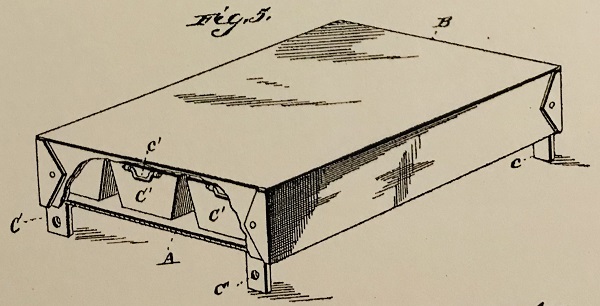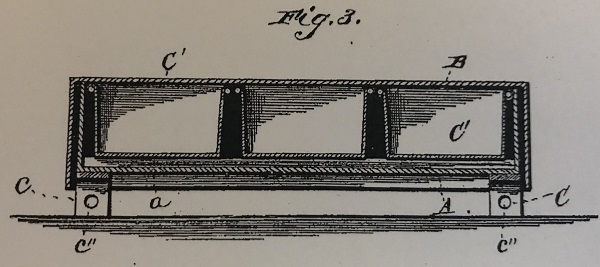
The U.S. Army's Buzzacott Camp Oven System
By
Patrick McSherry
Please Visit our Home
Page to learn more about the Spanish American War
General:
By the time of the Spanish American War, the Buzzacott stove had become
standard issue in the U.S. Army, and among some state National Guard
units. We know that the Buzzacott Stove was used in Cuba during the war as
there are references to the stove in the regimental history of the 2nd
Massachusetts Volunteer Infantry. One regimental history for the
regiment noted that:
" A few
days after the surrender [of Santiago]...the Buzzicot [Buzzacott]
field-cooking outfits, which we had brought from Massachusetts with us,
were also landed , and that of [company] G was at once set up...Private
Fisher, the company cook of [company] K, was ill, and [company] K's
Buzzicot was but little used."
The article below, taken from the 1896 Army Cookbook, explains the stove,
and its components and advice for its use.
The Buzzacott Stove was invented by Francis
Buzzacott. Buzzacott was a world traveler and adventurer. He served in the
British Army in the Boer War, and served three periods of enlistment in
the U.S. Army. He served under then lieutenant George Pershing at Fort
Supply, Indian Territory (later Oklahoma), which is where he apparently
with his stove design. He later served with the 3rd Illinois Volunteer
Infantry in the Spanish American War and then in the Quartermaster
Department in World War One. He also did things such as sail aboard
replicas of Columbus’ ships from Spain to the U.S. for the 1893 Columbian
Exposition, and late in life, traveled around the world in a vehicle of
his own creation that today we would term a recreational vehicle or “RV.”
Buzzacott, though he had no formal schooling, wrote five books on the
outdoor life and on evolution.
Buzzacott patented his "portable bake oven" on August 12, 1890. It is
patent #434,242.

The
Buzzacott Portable Army Stove as depicted in the 1890 patent
documents.
The stove was placed on a frame, the cooking / baking pans were placed
inside, and a cover placed over the entire apparatus
The Excerpt:
"Various portable stoves and ovens have been invented and placed upon the
market for use in camp cookery.
The Buzzacott oven is now generally used in the Army; it is an adaptation
from the Dutch oven. It consists of a large rectangular pan; the bottom is
made of sheet iron or steel, with a top of similar material.
It is compact and strong for transportation.
The outfit includes all the necessary utensils for roasting, baking,
frying, broiling, and stewing, as well as many of the cooks’ tools for the
use of a full company of seventy-five men. It is issued by the
Quartermaster’s Department, upon requisition, to United States troops, for
use in field and camp service.
… Inside are thirty to thirty-five utensils comprising the outfit. Size,
25 by 35 by 14 inches. Weight, 175 to 200 lbs., complete. In shipping, it
forms its own crate, and when thus closed this skeleton stove forms an
iron crate about the whole, fastens or binds it together and permits of
any heavy objects being packed on top of it without danger of crushing.
WHAT THE OUTFIT COMPRISES.
One skeleton stove (grate stand).
One extension stand.
Two parts of oven.
One large cover for oven (used when boiling water, etc.).
Two large baking and roasting spiders. Rests.
Two small frying spiders. Rests.
Two lifting-hooks or irons.
Two large combination frying, roasting, or baking pans, with covers,
Three large boilers (a set), with covers to fit.
These articles are of special make, handmade, and of selected material,
permitting of the rough and constant usage incident to field service.
UTENSILS PACKED WITH THE OUTFIT.
One butcher cleaver, 8-inch blade.
One butcher knife, 8-inch blade.
One butcher steel, 10-inch.
One 10-quart (seamless) dish or mixing pan.
One large sieve or strainer.
One large 3-quart dipper, handle 12 inches long.
One medium cup-dipper or ladle, handle 12 inches long.
One large cook's spoon, solid handle, 12 inches long.
One largo cook's flesh fork, 3-prong, handle 12 inches long.
Three largo dredges (salt, pepper, flour).
One large pierced ladle or skimmer.
Ono graduated scoop or measure, ½ pint to 2 quarts.
One large seamless colander.
One large turnover, solid handle, 12 inches long.
CAPACITY OF UTENSILS.
The largest boiler, full measure, 12 gallons, 48 quarts.
The medium boiler, full measure, 10 gallons, 40 quarts.
The smallest boiler, full measure, 8 gallons, 32 quarts.
Combined capacity, full measure, 30 gallons, 120 quarts.
Largest pan, baking (1 time), 100 biscuits, 30 pounds bread.
Medium pan, baking (1 time), 75 biscuits, 25 pounds bread.
Largest pan, roasting (1 time), 5 to 100 pounds meat.
Largest pan, frying (1 time), i5 to 100 pounds meat, fish, etc.
Largest pan, baking and roasting together, 50 pounds potatoes and 50
pounds meats.
Largest pan, baking beans, pudding, etc., 35 to 40 pounds.
If oven is used as a boiler, 10 to 15 hams can be boiled together in it,
or one barrel of liquid prepared. In an emergency only is this necessary.
DIRECTIONS FOR USING BUZZACOTT OVEN.
If the wind is blowing heavily dig a hole for the oven and fire of
sufficient depth to bring the top of the oven on a level with ground,
piling the wood on the edges of the bank for additional protection. If
weather is good there is no need of this.
When practicable use a tent fly as a shade for the cooks.
Use the best fuel for baking, and stack it so that it may dry. Splitting
or chopping wood is not required, except to first kindle fire.
Build a fire of any convenient fuel, wool, buffalo chips, leaves
(anything), and when well started, place over the fire your skeleton
stove.
Adjust the "extension stand” aIways to leeward (from the wind), so as to
catch or absorb the spare and draft heat, flame, etc.; use the “oven” on
this stand, and shift the stand was circumstances require for your
convenience.
When roasting or baking is desired in connection with boiling or frying,
place the oven on the stand crosswise, as that allows room for the other
utensils at the same time; or if preferrable, place it on a bed of coals
near the fire on the ground, or on a level fire.
Near the center of the inside of the oven place evenly apart the two large
pan spiders (rests). These support the baking and roasting pans and
contents and prevent an uneven circulation. Place these firmly and easily,
and your foods will roast and bake splendidly.
Prepare the roast, bread, pudding, or whatever you wish in the pan, place
it on the rests inside of the oven and cover with the upper part of the
oven; heap some fresh burning coals on top and the roasting or baking
commences instantly.
In using the oven keep a clean fire, free from sand and dirt. On top of
oven build a little fire, if necessary, from chips, etc.; regulate your
heat by the amount of fire - add to or remove when necessary.
Always build a fire or use live coals on top of the oven when either
roasting or baking.
The two smaller pan spiders (rests) are intended to he used on top of the
oven, over the fire that is built on top. On this do your boiling,
stewing, broiling, and frying with the utensils (provided with the outfit)
for the purpose.
Keep the oven covered as much as possible.
Basting is never required; to regulate the heat simply shift the fire, add
to or remove as necessary; judge cooking by time and strength of fire; add
water to the roasts for gravy, etc., and to assist its self-basting
qualities.
When roasting or baking is completed, take off the oven, remove the cover
and dump the ashes; recover it, and you can carry the oven and its
contents clean and warm, being careful to avoid spilling or capsizing the
food.
When removing pans with lifters, be careful to steady contents and lift
easily, lest they capsize and spill contents.
Use the oven for washing dishes, and the top for frying and stewing (in
addition to regular frying pan if desired).
The washing of pots, kettles, etc., will be easy if they are washed
immediately after use - before they cool - it will be done in one-half the
time with one-quarter the work. Set them bottom up to drain and keep
clean."

A
cutaway view of the Buzzacott Stove
Bibliography:
Commissary
General of Subsistence, Manual for Army Cooks.
(Washington: Government Printing Office, 1896) 216 – 220.
“On World Tour in ‘Cruiser Car,’” Chattanooga
Daily Times. January 26, 1929, 12.
Ward, Walter W., Springfield
in
the Spanish American War. Reprint by Wentworth Press, 2019, 44.
Support this
Site by Visiting the Website Store! (help
us defray costs!)
We are providing
the following service for our readers. If you are interested in
books, videos, CD's etc. related to the Spanish American War, simply
type in "Spanish American War" (or whatever you are interested
in) as the keyword and click on "go" to get a list of titles
available through Amazon.com.
Visit Main Page
for copyright data



